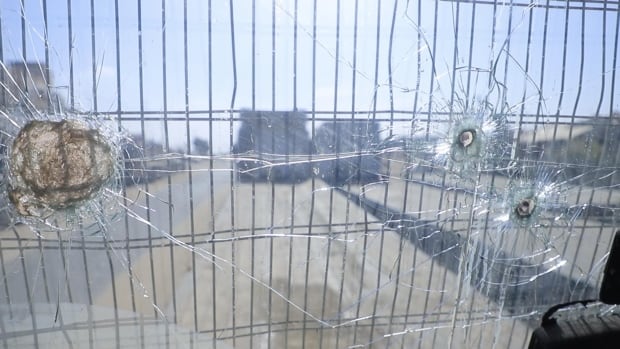While nowhere in Gaza can be considered safe, among the most dangerous places these days is anywhere there’s food.
Many of the roads used by humanitarian agencies to transport and deliver basic necessities have descended into chaos. The trucks that carry food are routinely attacked and looted.
And the spaces outside the territory’s few operating bakeries have become death traps, often jammed with desperate, hungry people climbing over each other to grab limited supplies of bread.
While Israel and Hezbollah have seemingly quieted their hostilities in Lebanon, the war grinds on in Gaza, with lawlessness emerging as the latest threat to a population already suffering from malnutrition, displacement and unrelenting attacks from the sky by Israel’s military.
Humanitarian groups, the heads of local clans and local business leaders all say Hamas’s grip on power in the territory is fading, and that it is empowering criminal elements that are taking over some of the militant group’s operations.
In the turmoil, 46-year-old truck driver Basel Shaheber says he was lucky to escape with his life after a recent aid delivery was targeted by looters.
“They shoot at our tires, they shoot at the driver, they shoot at everyone,” he told a videographer working for CBC News near the southern city of Rafah.

The cab of the truck beside him had the type of battle scars more typically seen on military vehicles such as tanks or armoured personnel carriers.
A large bullet hole just beside the driver’s seat shattered the windshield. A chunk of the front grate was missing from where another bullet penetrated. There were more bullet holes in the wheels of his cab.
“If you don’t do as you’re told, you die,” Shaheber said.
Several different sources told CBC News those making the demands are organized looters that steal aid meant to be distributed for free and selling it at vastly inflated prices.
A bag of flour on the black market can go for up to $300 Cdn a sack — a price only the richest families in Gaza can afford to pay. For everyone else, it’s often a chaotic crush to get what little food is available.
Two girls – ages 11 and 17 – and a woman were crushed to death waiting in a crowd of people to get bread at a bakery in the central Gaza Strip Friday.
The videographer working for CBC News witnessed scenes of pandemonium outside a bakery in Deir Al Balah on Friday, as hundreds of people were beaten back by men with sticks as they pushed forward to try to get loaves of pita. At least three people were killed, including two children.
Blame game
Who, exactly, is responsible for the rise in crime, price-gouging and challenges with distributing food and humanitarian aid is the subject of intense disagreement between Israelis and those in Gaza.
Palestinian sources say many of the gang leaders are escaped prisoners and members of well-known crime families who were freed from their jail cells after Israel bombed Gaza’s prisons.
But Israel has also faced widespread criticism for fuelling the thriving black market by creating food scarcity in Gaza.
International aid agencies, as well as the U.S. government, have said Israel must ensure 350 trucks are allowed into the territory every day — a number that has only rarely been reached.

In a social media post on Thursday, COGAT, Israel’s lead agency for delivering supplies to Gaza, said just 158 aid trucks had entered Gaza — about 200 short of the target. But it also noted that more than 730 trucks were still waiting to be unloaded on the Palestinian side.
COGAT says the problems with logistics and looting inside Gaza aren’t its fault, as the agency isn’t responsible for delivering food to Palestinians once aid trucks have crossed the border.
In another post, an Israel Defence Forces (IDF) official placed the blame for hunger in Gaza on international humanitarian agencies that are failing to deliver the aid waiting at the border, a charge the aid agencies vigorously deny.
“A surge in armed looting targeting humanitarian convoys and truck drivers, fuelled by the breakdown in public order and safety, has further crippled our ability to collect supplies from border areas and deliver critical aid,” said Muhannad Hadi, the UN humanitarian co-ordinator for the Occupied Palestinian Territory.
While not specifically mentioning Israel, Hadi’s statement said “safe and unimpeded humanitarian access across Gaza must be established,” as the survival of two million people is at stake.
Dangerous routes
In a well-publicized incident earlier this month, 100 trucks in a 109-truck convoy were violently looted, according to UNWRA, the UN agency for Palestinian refugees.
The head of a Gaza trucking association, Nahed Shuhaibar, whose company vehicles have been repeatedly attacked while delivering humanitarian aid, says Israel’s military increases the looting problems by directing aid trucks through dangerous areas, where they are targeted.
“Right now [the Israelis] provide a route for the looters to pass to do whatever they want,” he told CBC News. “If me or you go in, we are at risk, but the looter moves freely however he wants. We say this is an agreement between the looters and the Israeli army. This is something that is understood by all.”
Looters pick through a truck carrying humanitarian aid on one of the most dangerous streets, Salah El-Din, in Gaza, earlier in November.
He says Israel could do much more to improve safety for aid deliveries in Gaza, but that it won’t.
Aid agencies have repeatedly called on Israel to open up more and safer border crossings and to allow the use of container trucks, rather than open flatbeds, to better protect the cargo inside.
Israel’s government claims the closed containers could be used to smuggle weapons and are a security threat. Its government also recently opened up a crossing at Kissafim, in southern Gaza, that’s closer to a humanitarian hub.
Shuhaibar says the ongoing looting has left his fleet of trucks depleted. But Israel refuses to allow him to bring in new ones.
“We had about 250 to 300 trucks — now we only have 160 trucks, with 100 not working,” he said.
Authority weakened
Before the war, Hamas was the undisputed enforcer in Gaza. The militant group had its own militia and ran the territory’s bureaucracy, including the police and security services. But Israeli attacks have weakened the organization.
Of the 44,000 people the Gaza health authorities say have been killed since last October, Israel claims 18,000 were Hamas militants.
In a recent report card, international aid agencies said Israel has deliberately targeted members of Gaza’s police in their attacks.
Wissam Afifa, a political analyst and former director of a Gaza TV station, says Hamas has been dealt a major blow by 14 months of unrelenting Israeli attacks.
“Hamas’s governing authority has suffered a lot of damage and has been significantly undermined,” Afifa told CBC News. “It’s clear that the extent of the strikes received by the Hamas-affiliated government apparatus is completely unprecedented.”
Afifa says Hamas personnel — including police — are now rarely seen in public, as they know Israeli drones are watching for them.
“Today, we are talking about the presence of Hamas in very limited areas … which are concentrated in an area that does not exceed 30 to 40 thirty per cent of the Gaza Strip,” he said.
“There are no security agencies.”
Burgeoning smuggling
The breakdown of law and order has fuelled an increase in cigarette smuggling, say observers in Gaza, which has helped fuel the activities of the gangs. But it has also thrown an economic lifeline to Hamas.
Israel does not allow tobacco products in the territory. They are stopped at the border checkpoints by Israeli security, making cigarettes highly prized and extremely expensive.
With normal supplies of basic goods cut off because of the war, tobacco is often smuggled in, fuelling the looting of trucks and a black market where one cigarette can cost more than $50.
CBC’s videographer spoke to several vendors in Deir al Balah, one of whom said a single cigarette can cost up to $50 Cdn on the street.
“[Smugglers] bring the cigarettes in the imported products, in the noodle packets, in bags of chips, cleaning products, bags of flour,” said Mohammed Al-Faqawi, 24.
He says Hamas “collaborates” with the cigarette traders and takes a cut of the proceeds.
But the fact that tobacco is making its way into Gaza via aid trucks makes those vehicles an even greater target for looters, said Al-Faqawi.
Families take over
Paradoxically, the breakdown of law and order offers a potential view of a post-Hamas future for Gaza.
Some of Gaza’s influential clans say they are trying to maintain law and order themselves, including by protecting aid shipments.
CBC News spoke to Taha Al Astal, a Bedouin leader, who has been at the centre of the effort.
“We in Gaza have houses of families,” he said. “We have rules and regulations. We know what’s right and wrong. This will guide us through this chaos.”
Al Asta insisted “the gangs are outside our culture and traditions,” and that the group of families is working to round up those stealing aid and to clamp down on cigarette smuggling.
He acknowledges Gaza may be on the brink of famine, but says so far, the territory — where more than two-thirds of the structures are destroyed or damaged and almost two million people are displaced — has pulled together and people are looking after one another.
He emphasizes that the absence of official law and order services in Gaza is the fault of Israel’s attacks, and not because Palestinians are turning on each other.
“There is a level of chaos, but we are better off than Iraq, better off than Syria, which faced civil wars,” said al Astal. “Our families are connected and are bound together.”
More than 14 months into the Israel-Hamas war, Gaza is slipping into lawlessness and aid groups say the breakdown is threatening the survivial of up to two million people.






